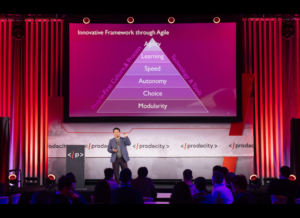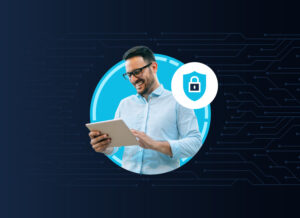In today’s rapidly evolving digital landscape, Government agencies face many challenges in delivering modern, secure software applications to the end-user. DevSecOps is a methodology that combines development, security and operations to create a more streamlined and secure software development process. This concept has emerged as a transformative approach that integrates security practices, automation and software factories into the software development lifecycles from its inception. At the Carahsoft DevSecOps Conference, industry experts and innovators shared their knowledge of emerging tools, effective strategies and methodologies in software engineering through several educational sessions.
Unlocking Efficiency: The Power of Automation and AI/ML
Automation helps developers improve the efficiency and quality of code, reduce risk and combat security vulnerabilities. As a key component of DevSecOps, automation allows developers to simplify many of the tasks involved in software development, such as testing, deployment and monitoring. Once automated, developers can focus on writing high-quality code and addressing security vulnerabilities, rather than spending time on redundant manual tasks.
The use of AI has transformed the way developers work, compared to 20 years ago when code was primarily written from scratch. Today, external libraries — software code written by a third-party source — are used frequently which introduces a new set of risks and benefits. The benefits include making software development faster and more efficient as developers use pre-existing code to build their applications. However, if a third-party library has a security vulnerability, it can be exploited by malicious actors to gain access to sensitive data. If not maintained properly, the third-party library can become outdated and incompatible with other software components.
 Software Factories
Software Factories
Software development has become an essential part of today’s business operations, and Government agencies are constantly seeking ways to improve their processes. Recently, the concept of the software factory—a structured approach to software development that emphasizes standardization, automation and collaboration—has gained popularity. It establishes a set of tools, processes and best practices that enable teams to develop software more efficiently and effectively. The goal of a software factory is to create a repeatable and scalable process for software development that can be applied across different projects and teams. By implementing this strategy, agencies can improve the quality, speed and consistency of their software development efforts.
One of those best practices, Continuous Integration and Continuous Deployment, are combined in a single process known as CI/CD. CI is the practice of frequently merging code changes from multiple developers into a shared repository, where automated tests are run to address integration issues early in the development cycle. This ensures the code is always in a releasable state and reduces the risk of conflicts and errors when changes are merged. CD, on the other hand, is the practice of automatically deploying code changes to production as soon as they pass the necessary tests and checks. Thus, enabling teams to release software changes quickly and frequently. By utilizing CI/CD, teams can achieve a continuous flow of code changes from development to production, which is imperative for modern software development.
Elevating DevSecOps: A Blueprint for Integrating Early Software Security Measures
Securing software in a containerized environment presents unique challenges due to the dynamic nature of containers and the distributed nature of container orchestration platforms like Kubernetes. Government agencies must ensure that containers are properly configured and secured, as misconfigurations can lead to vulnerabilities that can be exploited by attackers. Another difficulty is detecting and responding to security incidents in a timely manner, as containers can be spun up and down quickly and may be spread across multiple nodes in a cluster. Securing software early can help agencies reduce risk, lower costs, deliver software faster and improve collaboration between development and security teams.
Another crucial component of DevSecOps—continuous delivery—enables teams to deliver software changes quickly, safely and sustainably. This means that teams can release software changes frequently and with confidence, knowing that the changes have been thoroughly tested and are ready for production. Through a combination of automation, collaboration and feedback loops, continuous delivery helps reduce the time and effort required to release software changes.
Agencies can adopt a DevSecOps approach that integrates security into the software development lifecycle from the beginning. This involves using tools and processes to automate security testing and validation, as well as incorporating security requirements into the development process. For instance, agencies can use tools like vulnerability scanners and security-focused container images to detect and remediate vulnerabilities in containers. They can also use automation to validate security requirements and ensure that containers are properly configured and secured.
Securing software early in the development process can lead to several benefits including:
- Reduced risk of security incidents: By identifying and addressing security vulnerabilities early in the development process, agencies can minimize the risk of security incidents and data breaches.
- Lower costs: Fixing security issues later in the development process is much more expensive than addressing them early on. By integrating security into the development process from the beginning, agencies can reduce the cost of fixing security issues and avoid costly rework.
- Faster time to market: Adopting DevSecOps approach can help agencies to deliver software faster by automating security testing and validation. This decreases the time for manual testing and enables faster release cycles.
- Improved collaboration: Agencies can strengthen collaboration between development and security teams to ensure requirements are properly understood and incorporated into the development process. This proactive initiative can help foster a culture of security throughout the agency.
The adoption of DevSecOps, along with its fundamental principles, empowers Government agencies to establish a more efficient and secure software development process. This is achieved through the implementation of automation, the adoption of a software factory approach and the early integration of security measures.
To learn more about DevSecOps best practices and trending innovations, visit Carahsoft’s DevSecOps vertical solutions portfolio.
*The information contained in this blog has been written based off the thought-leadership discussions presented by speakers at Carahsoft’s annual DevSecOps Conference.*








